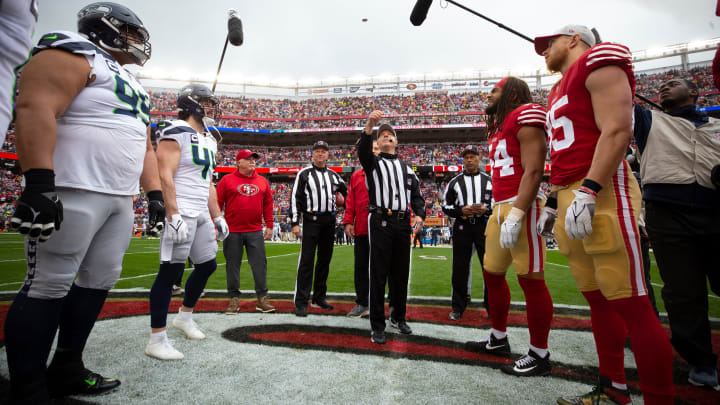NFL tiebreaker rules: How are ties decided in division, playoff standings?
Nothing beats the old coin flip when it comes to tiebreakers, but there are far more less-random options.
By Peter Panacy

NFL tiebreakers can be confusing at times, but there is actually some sound logic to determine outcomes.
At the very end of many of the NFL's tiebreaking protocols, there's the dreaded (or highly anticipated) coin flip.
Just think, a team's trip to the postseason can ride on whether or not someone called heads or tails. All things said, though, a 50-percent chance is certainly not the worst odds out there if all other things are equal.
The NFL tries to make things not equal in this regard, though. Unlike baseball, basketball or hockey where there are dozens upon dozens of regular-season games, the fact football has only 17 regular-season games inevitably means there will be squads with identical records at the end of the season.
Considering that 14 teams (seven from each conference) make the NFL playoffs, it's helpful to know what happens when two or more of those teams finish with the same record.
NFL tiebreakers within the same division
Back in 2019, the San Francisco 49ers needed a wild Sunday Night Football win over the Seattle Seahawks in Week 17 to ensure both NFC West rivals didn't finish with identical 12-4 records.
Had the Niners lost that game (they didn't), they would have lost a tiebreaker with the Hawks because of head-to-head matchups, meaning Seattle would win the NFC West and San Francisco would drop down to a Wild Card team.
By winning that game, the 49ers not only secured the division but also the No. 1 seed in the playoffs.
From NFL operations, had the Niners lost that game, the following would apply:
- Head-to-head (best won-lost-tied percentage in games between the clubs)
- Best won-lost-tied percentage in games played within the division
- Best won-lost-tied percentage in common games
- Best won-lost-tied percentage in games played within the conference
- Strength of victory
- Strength of schedule
- Best combined ranking among conference teams in points scored and points allowed
- Best combined ranking among all teams in points scored and points allowed
- Best net points in common games
- Best net points in all games
- Best net touchdowns in all games
- Coin toss
There's that dreaded coin toss again.
NFL tiebreakers for Wild Card teams
Things are almost always interesting when looking at Wild Card teams. Often, these squads will have better regular-season records than division winners, which is why a sub-.500 team can make the playoffs if the rest of the division was awful. Except that division winner still winds up getting a home game.
Also, all too often, there are a bunch of Wild Card teams bunched up for seed Nos. 5 through 7, many of which share identical records.
Should that be the case, NFL operations implements the following tiebreakers:
- Head-to-head, if applicable
- Best won-lost-tied percentage in games played within the conference
- Best won-lost-tied percentage in common games, minimum of four
- Strength of victory
- Strength of schedule
- Best combined ranking among conference teams in points scored and points allowed
- Best combined ranking among all teams in points scored and points allowed
- Best net points in conference games
- Best net points in all games
- Best net touchdowns in all games
- Coin toss
If three teams are involved, which can happen, the league will "apply the division tiebreaker to eliminate all but the highest-ranked club in each division" and can use a head-to-head sweep, if one team has played the others and beaten them both/all (this is rare).
As you can see, the league builds in a complex web of tiebreaking procedures.
However, a good old-fashioned coin flip is always exciting.
Read more from Niner Noise
feed